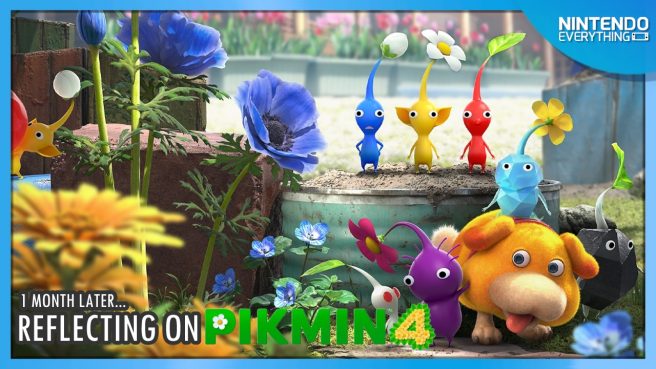The wait for Pikmin 4 was unexpectedly long. When the game was first revealed by Miyamoto in 2015 it was said to be “close to completion” but after this it wouldn’t be until eight years later that we would finally see the game released on Switch.
Now that we’ve all had time to venture out into the world of PNF-404, let’s take a closer look at the latest installment in the Pikmin franchise, what it brings to the series, and what this could mean for the future.
A New Chapter?
For the first time in the series the story isn’t centered around Captain Olimar, but instead on a player-created character, who is part of the Rescue Corps. A team of seven including your character, the Rescue Corps’ goal is to find Captain Olimar, who has mysteriously disappeared after sending out a distress signal, and to rescue several other castaways who have found themselves stranded on PNF-404 for various reasons. Admittedly the story here is nothing to write home about, but immediately broadens the setting in a way not seen before in the Pikmin series, introducing new concepts, characters, and the possibility of a world beyond its limited scope.
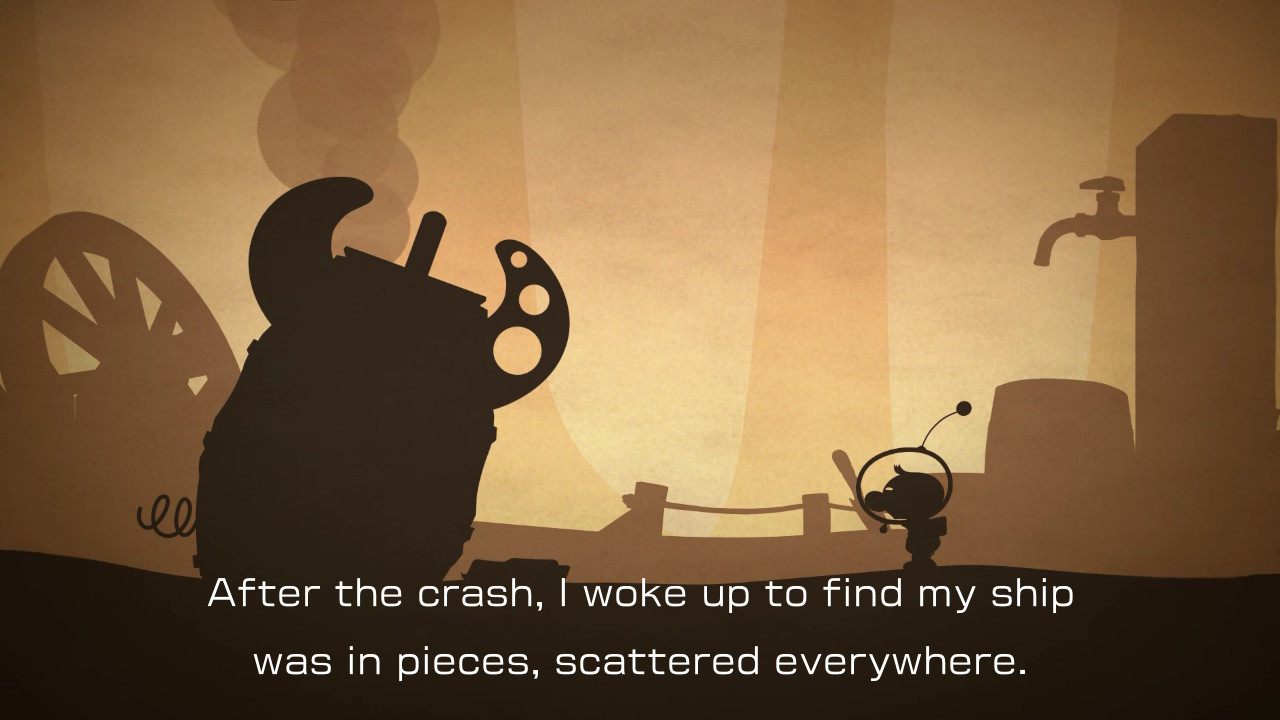
Pikmin has always been a series that forgoes an involving narrative in favor of more subtle worldbuilding and lore that invites speculation and imagination, and Pikmin 4 is no different in that regard: the main story that players will experience is a simple one, with finding Captain Olimar and the other castaways always being the primary goal during exploration. But if you look deeper, you will find that there is far more to engage with than you may have first thought.
PNF-404 is clearly reminiscent of Earth, and signs of human habitation can be seen in both the locations that you travel to (with the Hero’s Hideaway being a giant-sized ground floor of house as the most blatant example of this) and the treasures that you find scattered around. However, there are no signs of human presence and the local wildlife often only has vague similarities to their real-world counterparts, or is completely alien in appearance. This has been a common recurring theme throughout the Pikmin series, and whether this is just a fantasy world with similarities to Earth for the sake of familiarity or some dark and distant post apocalyptic future where humanity has been wiped out and animals have undergone some terrifying mutation is open to interpretation.
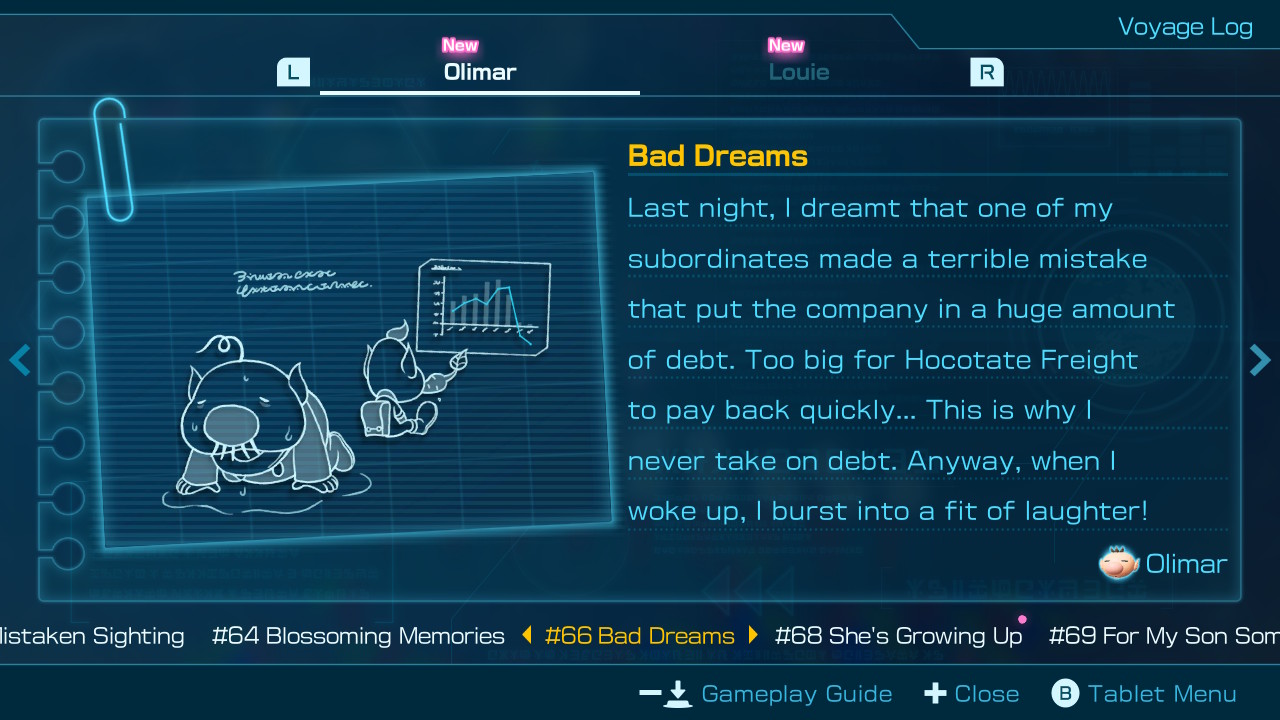
Pikmin 4 takes this one step further however by potentially completely shaking up the timeline of events from previous games. As you explore PNF-404 on the trail of Captain Olimar you will be given entries from his personal logbook, which act as both a soft tutorial for game mechanics and as a way of building up the world that you find yourself stranded on. But most interestingly, events from the previous Pikmin titles are clearly referenced in these, and they often suggest that these events haven’t happened yet, or will never happen. Upon completing the game you will unlock “Olimar’s Shipwreck Tale” which serves as a prologue to the events of the main story, but also acts like a re-telling of the original Pikmin, where you’ll need to find 30 ship parts within the time limit.
Interestingly, in the second Ask the Developer interview, Yutaka Hiramuki commented that the game was designed so that new players would be able to jump in without needing any prior knowledge from the previous games, but that the timeline of events would be up to the player’s imaginations. Whilst these could just be Easter Eggs for fans, Nintendo series aren’t above having excessively convoluted and confusing timelines, so whether Pikmin 4 is a continuation of the series, an entirely new chapter, or even a soft reboot for the franchise, remains to be seen.
Redefining Strategy
Pikmin has always been a series about time management: thrown into an alien world, you’re constantly under pressure from an in-game timer, which gives you a set number of days to complete your goals. Whilst this pressure would ease with each successive game, each one came with a hard time limit: eventually, the game would come to a forced end. Pikmin 4 does away with this limitation, and redefines its strategy gameplay through the concept of Dandori, a Japanese word which refers to the ability to “organize tasks strategically and working effectively to execute plans”.
Whilst elements of time management are still present in Pikmin 4 these are more on the micro-level than they are the macro-level: Dandori Battles and Challengers have a short timer of a few minutes for you to accomplish a specific goal, and Night Explorations are noticeably shorter than your standard day. The timer is still a present feature that will dictate your pace on a day-by-day basis, but there is no rush to do everything within a set number of days, letting you set your own pace. Pikmin 4 will tell you how many days you’ve been on the planet, but it doesn’t impose any restrictions on you based on this. Many might see the removal of that hard time limit as a negative thing, making the game an easier experience overall, but it allows for a wider variety of strategic gameplay that presents its own kind of challenge.

Freedom from the need to rush means that the game favors a more methodical approach to gameplay, allowing for greater optimisation in strategy. You are only able to take three different types of Pikmin with you at a time, and whilst this limits the complexity of the puzzles you’ll encounter, it places a greater emphasis on the need to choose the right Pikmin for each task. This is especially true in caves, where you are limited to the Pikmin that you take with you, unless you happen to find any whilst exploring. Time passes more slowly when you are inside caves (something that did not happen in Pikmin 2, which was the last time we saw these in the series) allowing you to take your time and carefully plan your way through each floor.
This is not to say this limitation means that there isn’t room for creativity when it comes to problem solving, particularly outside of caves. For example, you could freeze a body of water with Ice Pikmin to allow other types to cross unimpeded instead of taking nothing but Blue Pikmin, and this may prove to be a better strategy if there is a strong enemy or heavy treasure waiting on the other side. But will you be able to carry it back if half your Pikmin are freezing the water? The game encourages you to consider which Pikmin would be best suited to each task, but it rarely forces you to use specific Pikmin to achieve your goals.
Each Pikmin has its own strengths and weaknesses, and during the main campaign you can find a total of three onions – Yellow, Blue, and Ice – to allow you to create different types of Pikmin in addition to the Red ones that you start with. With the exception of the Ice Onion, you’ll encounter these naturally as you explore, so the gameplay will gradually become more complex. There are five additional species of Pikmin that you will encounter in caves (or in the case of Glow Pikmin, during Night Expeditions) rarely and will be unable to make more of, making them a valuable resource for much of the game, adding an additional layer of strategy: when is the right time to take them with you?
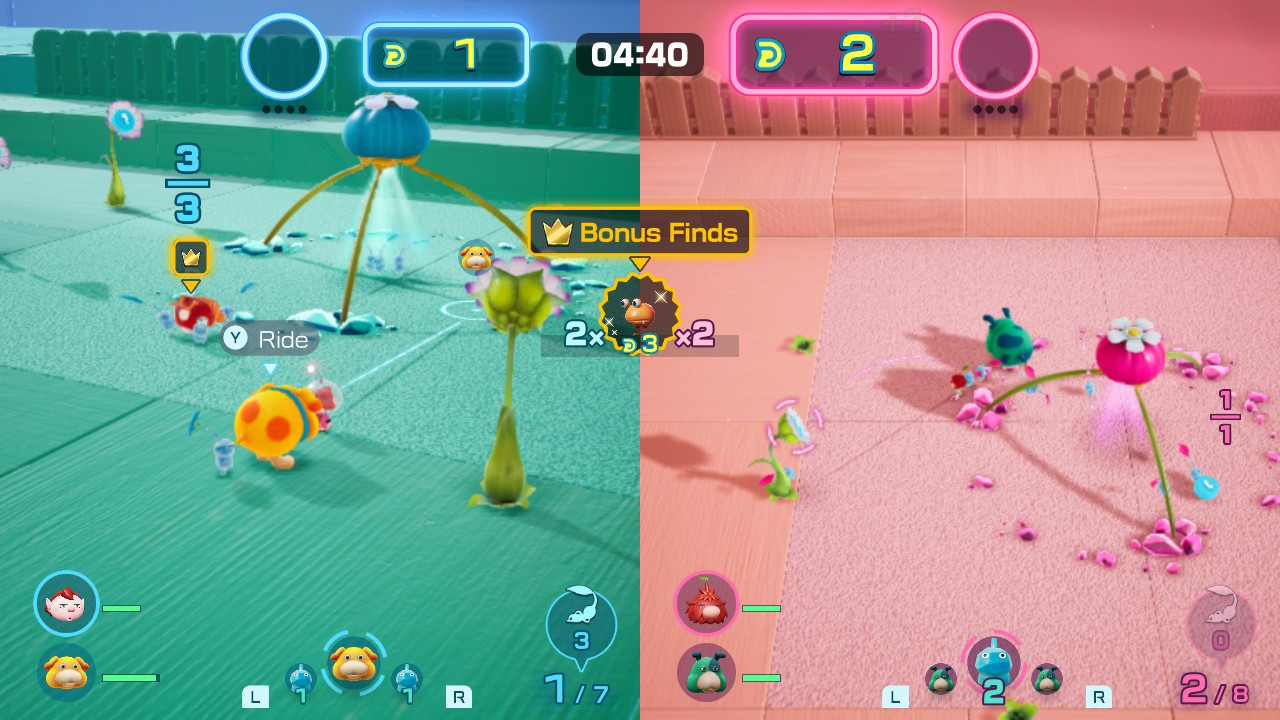
If the game’s open areas are testing grounds for your puzzle solving and resource management abilities, then Dandori Battles and Challenges are where they’re really put to the test. In these you’re given a very short timer – typically no longer than five minutes – to accomplish a specific goal. In battles, this is generally to gather more resources than your AI-controlled opponent, who also has their own squad of Pikmin and canine companion. This shakes up the gameplay quite dramatically, forcing you to think more efficiently rather than methodically, requiring you to keep an eye on your opponent’s movements, their score, and the time limit, and plan your moves accordingly. This need for speed and efficiency mirrors the approach that previous games in the series took to strategy in many ways, only on a much smaller and more urgent scale.
Oatchi and You
In Pikmin 4 you control a customisable character, made from a limited character creation tool at the start of the game, followed by your faithful canine-esque companion, Oatchi.
Oatchi completely changes the way that you play the game and is a character in his own right, being capable of doing almost everything that the player character can do, and many things that they can’t. Oatchi is faster than the main character, can carry Pikmin across bodies of water, attack enemies, sniff out nearby treasure and castaways, jump, and carry items. He’s also ridiculously adorable.
In many ways, Oatchi is a tool with all of the strengths of the various types of Pikmin and none of their weaknesses, and he only continues to gain utility as you progress through the game, with several skills unique to him that can be upgraded via Pup Points gained from rescuing castaways. This gives him a huge amount of flexibility: you can turn him into a tank capable of dashing through enemies or felling them in a single blow, focus on resource-gathering by increasing the amount he can carry, or give him a little of everything so he’s useful for whatever situation you may find yourself in. Oatchi can also be controlled separately from the player character, and commanded to carry out tasks independently, making him a valuable additional strategic resource.
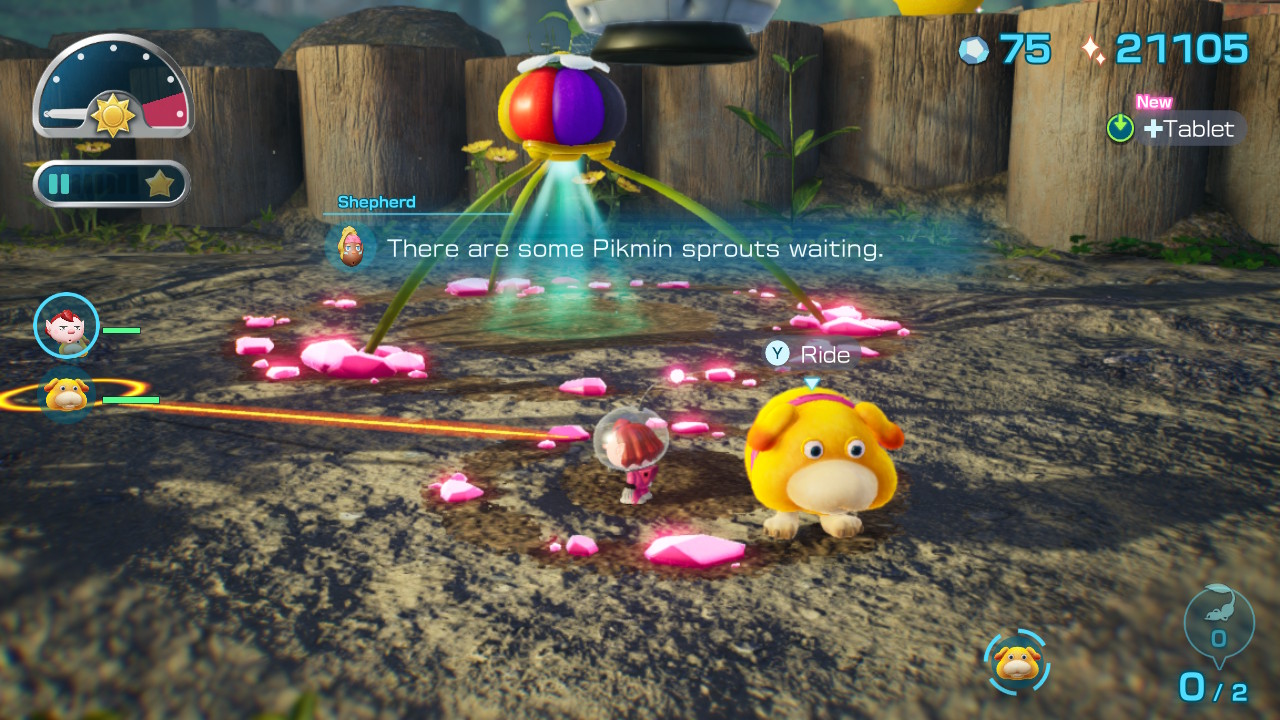
Interestingly, both your character and Oatchi can be customized, using resources found on the planet to purchase upgrades back at base to provide benefits such as resistance to hazards and increased health. These resources are not finite, but are limited for much of the game – for Oatchi especially, who will earn Pup Points depending on the number of Castaways you rescue – adding another level of strategy to the game by requiring you to pick between multiple different upgrades. It’s unfortunate that these points cannot be refunded to allow for the flexibility of different builds depending on the situation, but this comes with its own benefit of adding weight to your choices by forcing you to consider what will be most useful to you as you continue to explore.
Pikmin and Possibilities
Pikmin 4 introduces two new types of Pikmin: Ice Pikmin, which can freeze enemies, certain objects, and small bodies of water; and Glow Pikmin, which are unique to the new Night Expeditions but can also be found in caves.
Ice Pikmin are functionally just another species of Pikmin, similar to the ones introduced in Pikmin 2 and Pikmin 3, acting as an additional way to interact with the environment and solve puzzles. Their ability to freeze enemies allows you to take a more direct approach if you don’t care to exploit specific weaknesses, at the cost of resources due to their body shattering when frozen rather than leaving behind a corpse. Being able to freeze water also removes the need for Blue Pikmin in some instances, giving you more flexibility in which Pikmin you choose to take with you when exploring.
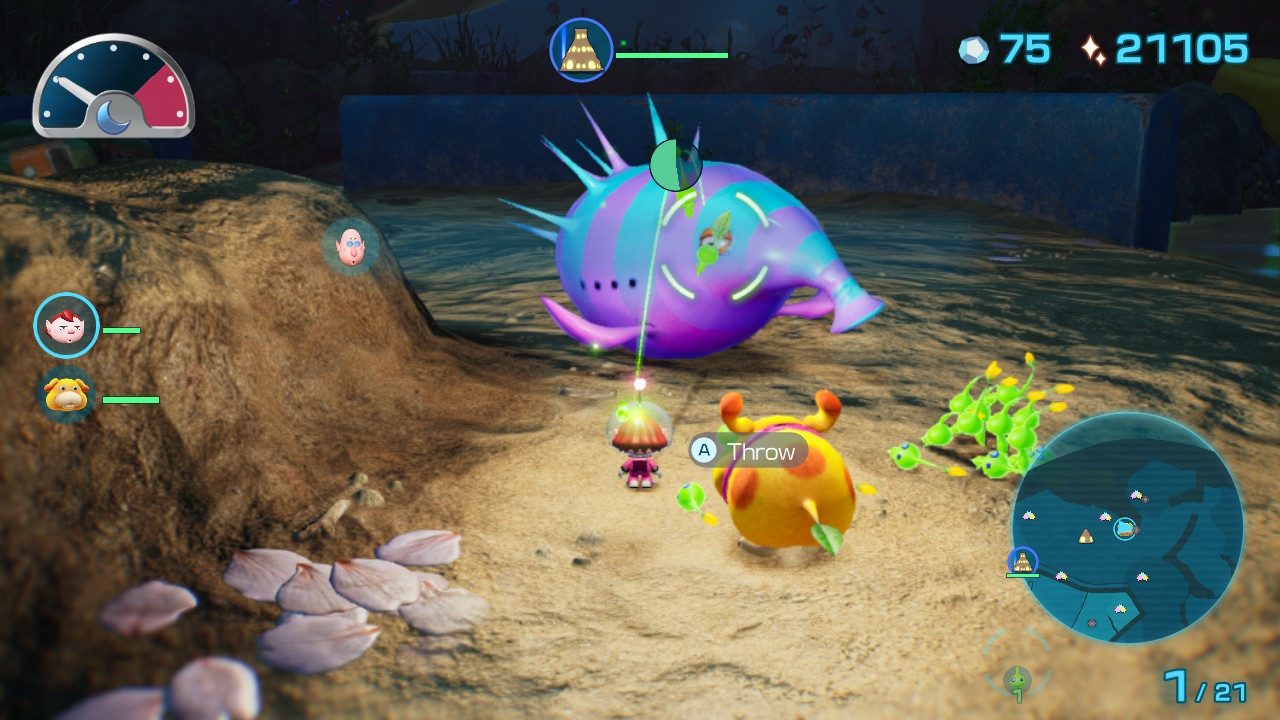
But it is Glow Pikmin that are particularly interesting, introducing an entirely new gameplay style to the game. In Night Expeditions, you can only utilize Glow Pikmin to defend against waves of enemies until the morning comes, in a simplified form of tower defense gameplay. Night Expeditions are shorter than your average day, but slightly longer than most Dandori Battles and Challenges, creating a nice middle ground between the two, and Glow Pikmin are immune to most forms of hazards, making the emphasis more on creating as many as possible and directing them efficiently to combat threats than on making using of only a limited number. This makes them functionally unique amongst Pikmin and potentially an exciting glimpse into the future of the series, despite the relative simplicity of Night Expeditions.
Accessibility and Quality of Life improvements
Pikmin 4 is the most accessible the series has ever been, and boasts a wealth of features and quality of life improvements that make traversing its various landscapes easier than ever. More than anything else the game clearly wants you to explore each of its meticulously designed areas, and facilitates this in such a way that newcomers to the series will find help where needed, and veterans can dive straight in without having to worry about the game constantly stopping them to tell them something they already knew or would have preferred to have discovered for themselves.
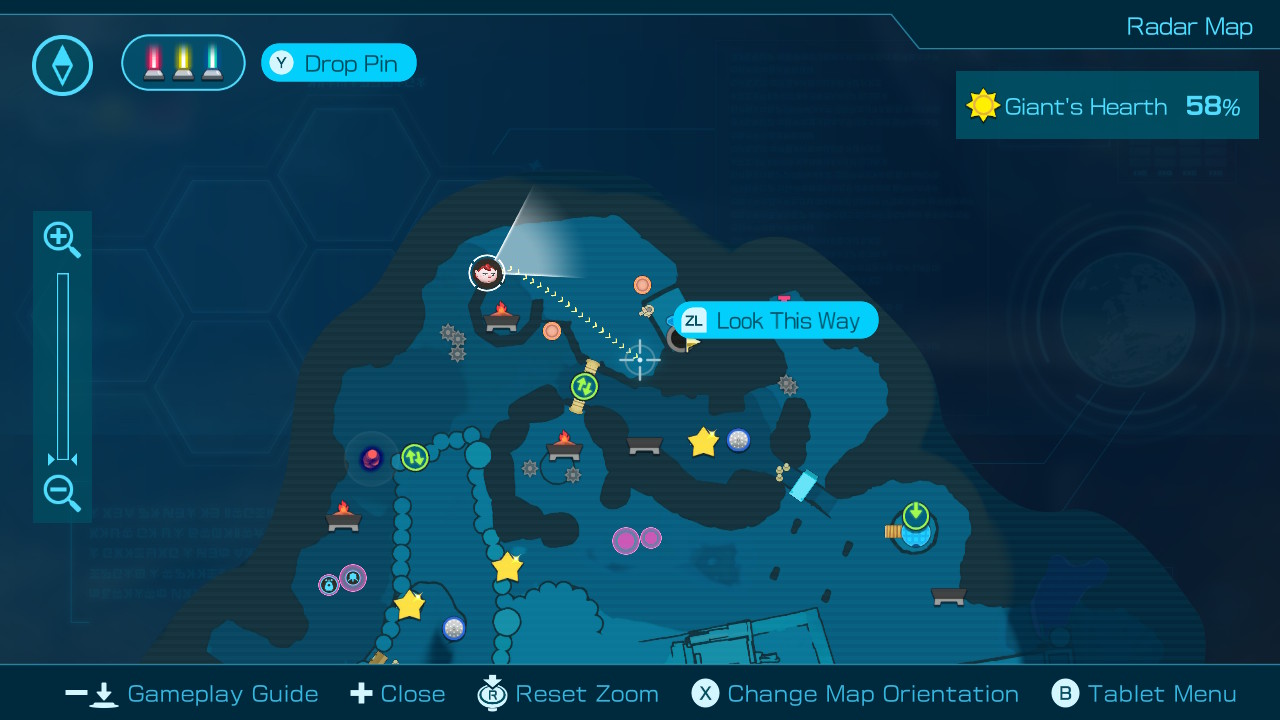
The in-game timer, whilst still an important game mechanic that puts a hard lock on how much you can accomplish in a single session, feels more like a inclusion through tradition rather than necessity: it’s a way of measuring the time you play, or of giving you a convenient time to stop, instead of something that you need to be constantly mindful of. The game will forcibly eject you from the map and back to your ship once the timer runs down, but there is nothing to stop you from simply going back and picking up right where you left off: enemies will remain deceased where they fell, and treasures you failed to carry back to your ship in time will be where you left them. Gone is the finite amount of time you have to accomplish your objective; you can remain on PNF-404 for hundreds of in-game days (which are thankfully quite a bit shorter than real time!) if you choose, building up your army of Pikmin, slaying anything that dares to stand in your way, and unlocking every secret that each of the game’s areas has to offer.
Not sure which Pikmin to take with you? There is an option where the game will automatically select from your pool of available helpers, giving you the best chance of survival. This is especially helpful in caves, where you may not know what lies ahead and won’t be able to simply go back to your ship and make more Pikmin. The in-game map is as comprehensive as you could ask once uncovered, showing you where treasures, cave entrances, and other obstacles are. If you can’t get to where you need to go, you can pull up the map and select “Go Here” to have your character move automatically, saving needless frustration if you’re trying to get somewhere in a hurry.
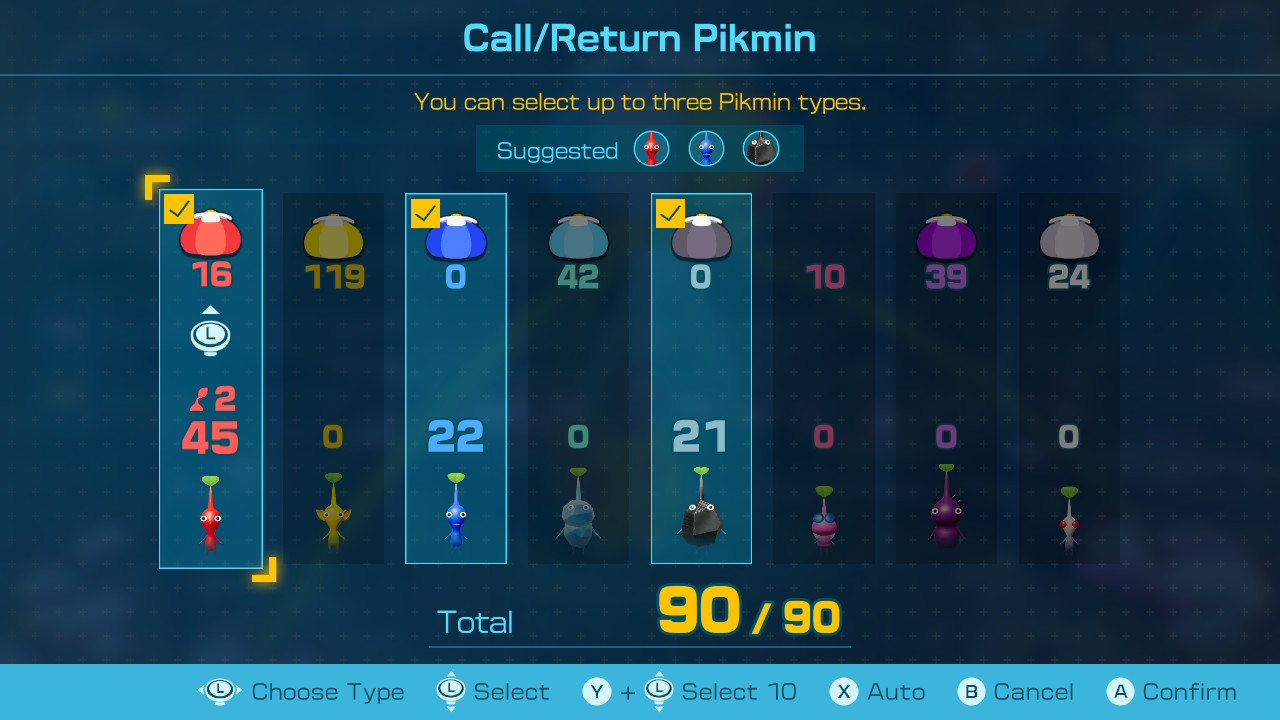
Pikmin 4 also recognises that even the best of us make mistakes, and there is nothing quite as disheartening and off-putting as losing progress because of this. Pikmin are a means to an end, and grinding for resources to meet that end isn’t what the game is about. To that end, Pikmin 4 implements a Rewind Time feature, which lets you return to either a few minutes prior to what was probably a very unfortunate mistake, or to the very start of the day. This is by no means a precise and perfect solution to the problem – rewinding a few minutes can see you lose progress that you actually wanted to keep and wind up at a seemingly arbitrary autosave point – but it does cut down on the need to waste time harvesting flower seeds and smaller enemies to build up your army in the event of a loss you can’t afford to take.
That Postgame Grind
It’s not uncommon for the “real” game to begin with the postgame. Once you have finished the main story, the game assumes that you are familiar enough with how it works to see what it truly has to offer: your skills are honed, and it is going to test them. Pikmin 4 takes this concept and runs with it to almost absurd degrees, with the postgame story unlocking two entirely new areas and an entire game’s worth of content in Olimar’s Shipwreck Tale, which is as long as the original Pikmin and plays exactly the same, granting the wish of those who longed for the hard time limit from the earlier days of the franchise.
In the postgame, the gloves come off: the game pulls no punches when it comes to enemy encounters and Dandori battles. What was once a fairly gentle and casual experience becomes a challenging gauntlet that will delight fans of previous entries in the series, as Pikmin returns to its roots to become a game about resource management in the face of impossible odds. It’s a good thing the time limit is gone, because you’re probably going to need a few days to build up your supply of Pikmin before you’re done, and that Rewind feature is going to come in handy as well, because you probably will make mistakes as you learn enemy placement, attacks, and weaknesses. Or just throw hundreds of Pikmin at the problem until it goes away, heedless of their cries as their souls form a mist so thick you could probably walk on it. Going for Platinum medals in the Dandori battles and challenges? Good luck! However you wish to challenge yourself, Pikmin 4 has you covered.
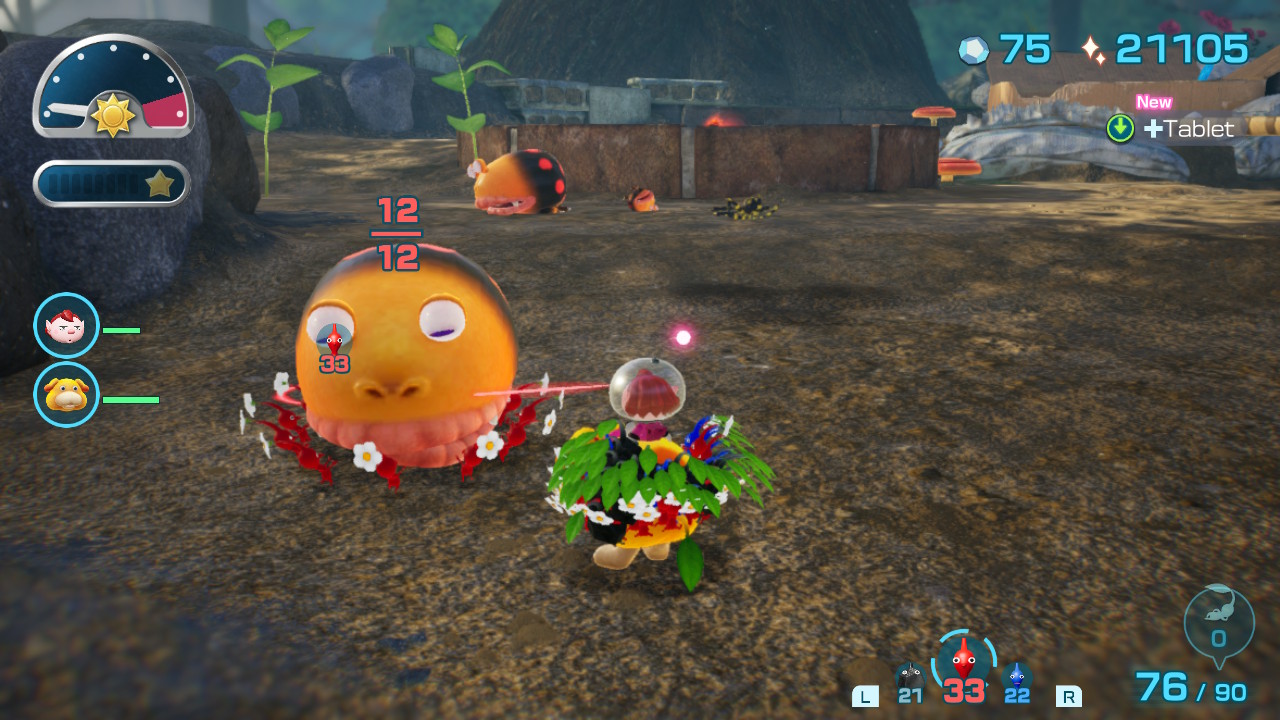
The rewards for this are more than worth it. Four species of Pikmin that you would have only previously been able to find in caves are yours to command in endless supply if you can find their Onions, and the postgame story sees the return of characters from the previous entries in the series, as well as an expansion of the lore as new logbook entries are acquired. If you were left dissatisfied by the ease with which you completed the roughly ten-hour campaign, the postgame will justify your patience and your purchase by testing your Dandori abilities to their fullest.
Pikmin 4 offers an acceptable compromise by providing a complete, accessible, and fairly satisfying story that anyone can enjoy, and then offering a postgame that will provide the challenge that has become a hallmark of the series and apparently turned so many away from it. It’s unfortunate that there isn’t really a middle ground between the two, with the difficulty spiking considerably the minute after the credits roll and you jump into the next area you unlock, but the attempt to provide something for everyone has paid off well, with all difficult content being optional, and all accessibility features being things that you need to actively engage with in order to utilize.
Multiplayer: Room for Improvement
If there is one area where Pikmin 4 is surprisingly lacking, it is in its multiplayer component. Players can compete in Dandori battles against one another or against an AI: a logical inclusion for the game, which bases itself around the concept in its various forms. But in the campaign a second player can only throw stones at enemies, making them a minor annoyance at best. Given Nintendo’s proclivity for multiplayer (even if it is often confined to couch co-op) this seems shockingly short-sighted and lackluster, especially when compared to Pikmin 3 Deluxe, which had a fully co-operative campaign.
With Pikmin 4 having both customisable main characters and Oatchi, it feels like a wasted opportunity that full co-op play wasn’t included for the main story. It would have been easy to have a second player control Oatchi separately, as this is something that the player can do, and would have perhaps been easier than letting them create an entirely separate new character with their own Oatchi equivalent, although the possibility of four-player co-op play with two player-created characters and two Oatchi is an interesting one. Perhaps this was a deliberate omission, to be added later as a title update, DLC, or a feature for a Deluxe version of the game on Nintendo’s next console?
So, What Next?
Through the concept of Dandori, Pikmin 4 introduced several features that took the gameplay in entirely new directions, making it the series’ most diverse and accessible title to date. The eight year wait was long, and the silence was painful, but the payoff was more than worth it: this is a game that anyone can enjoy. With all of that said, where does Pikmin go from here?
With such large areas and a greater focus on exploration, an open world seems like a logical next step for the series, although this would clash with several features: most notably, the day and night cycle, and the need to return to your ship each night. It would be difficult to really explore the world if you were forcibly pulled back to a starting point constantly, and fast travel points wouldn’t mitigate this issue entirely. It’s difficult to imagine what Pikmin would gain from an open world that it hasn’t already gained from the features implemented in Pikmin 4.
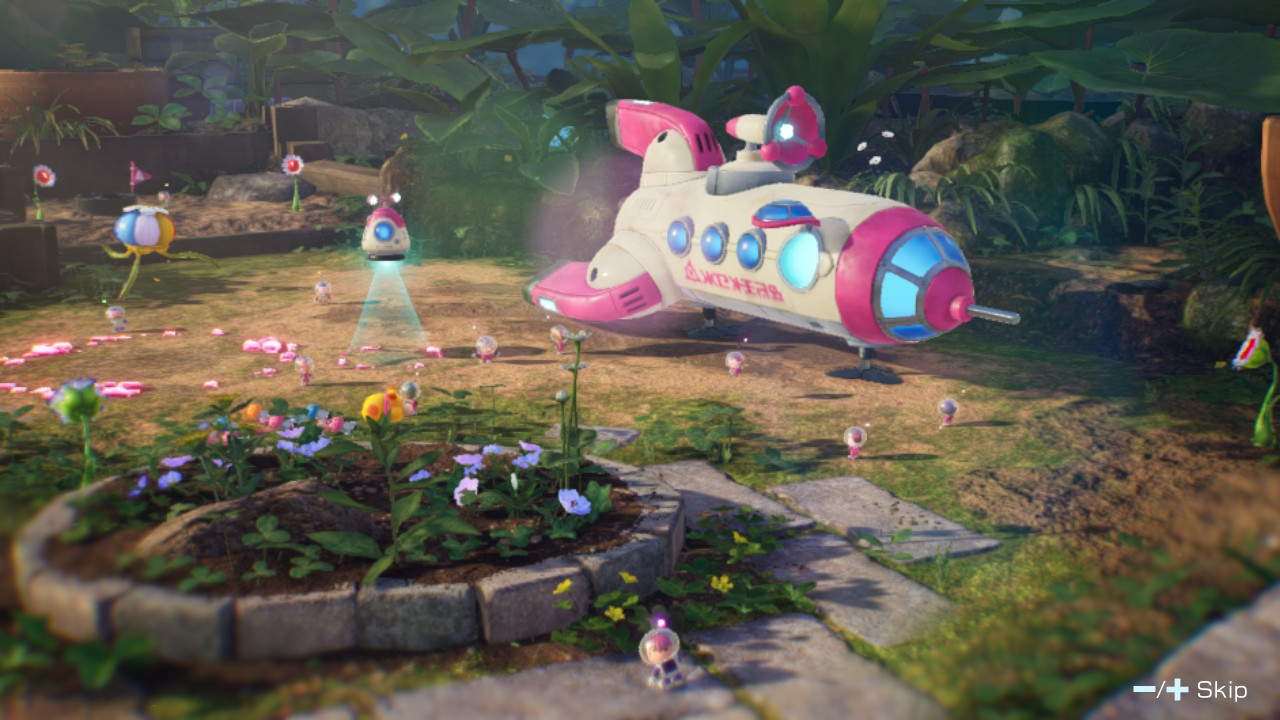
New species of Pikmin for the next installment are almost a foregone conclusion, as the gameplay revolves entirely around managing them and having them interact with the environment. However, with Glow Pikmin being the focus of a tower-defense based gameplay mode, the possibility of other new species of Pikmin introducing new gameplay modes, rather than simply fitting into those that already exist, is an exciting and interesting one that Nintendo will hopefully continue to explore.
Whilst the story of Pikmin 4 was a simple and relatively mundane affair, its wider implications for the series as a whole have yet to be seen. Will there be a Pikmin timeline? If so, where does Pikmin 4 fit into it? With Pikmin 4 it feels as though the series is just beginning to broaden its horizons, introducing new concepts and lore to what was previously little more than a setting vaguely reminiscent of Earth for the sake of familiarity. It will be interesting to see what, if anything, Nintendo decides to do with the world of Pikmin moving forward.
Were you satisfied with Pikmin 4? What would you like to see in future games in the series? Let us know your thoughts in the comments.
Pikmin 4 copy provided by the publisher for the purposes of this feature.
